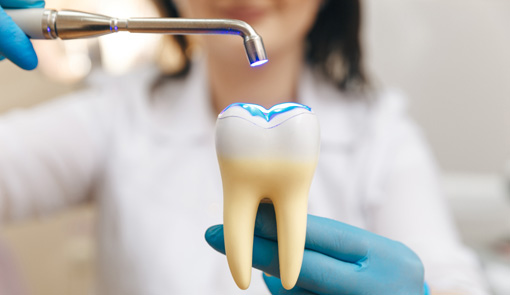If you’re dealing with a damaged or decayed tooth, you may have heard the terms “dental crown” and “filling” being used by your dentist. But what exactly do these terms mean, and which one is the right choice for you? Understanding the difference between a dental crown and filling is essential for making an informed decision about your oral health.
At Journal Square Dental, our team of experts is dedicated to helping you achieve a healthy and beautiful smile. Contact our team to schedule a consultation and discuss which option is best for you.
What Is a Filling and When Is It Used?
A filling is essentially a way to restore a tooth damaged by decay back to its normal function and shape. When you get a filling, the dentist first removes the decayed tooth material, cleans the affected area, and then fills the cleaned-out cavity with a filling material. This material can be made from a variety of substances, including gold, porcelain, silver amalgam, tooth-colored plastic, or from composite resin fillings.
Fillings are most commonly used when there’s a cavity, which is a small hole in your tooth caused by decay. The filling closes off spaces where bacteria can enter and helps prevent any further decay. They are the go-to treatment for minor tooth decay and cavities, where the structural integrity of the tooth isn’t significantly compromised.
Choosing a filling is typically straightforward for small to moderate cavities. It’s a less invasive procedure than getting a crown and usually requires just one visit to the dentist. However, if the decay or fracture damages a large portion of the tooth, a filling might not be enough, and your dentist may recommend a crown instead.
What Is a Dental Crown and Its Purpose?
A dental crown acts like a protective hat for your tooth. It’s used when a tooth is significantly damaged or decayed more than what a filling could repair. Imagine it as a custom-made cover that sits snugly over the entire top part of your tooth, right down to the gum line. Crowns can be made from various materials including metal, porcelain, resin, or a combination of these, offering durability and a look that matches your natural teeth.
The main purpose of a crown is to restore a tooth’s shape, strength, and function. It’s like giving your tooth a new lease on life, allowing it to be used just like any healthy tooth for biting and chewing. Crowns are often the best choice when not only the surface but also the structure of the tooth is compromised. They can hold together parts of a cracked tooth or even restore a tooth when there isn’t much left.
Beyond fixing functional issues, crowns are also used for cosmetic reasons, enhancing the appearance of a tooth that is discolored or badly shaped. In short, a dental crown is all about protecting and reinforcing, ensuring your tooth – and your smile – stays strong and bright.
How Do You Decide Between a Filling and a Crown?
Deciding between a filling and a crown often comes down to the extent of tooth damage. For smaller cavities and minimal decay, a filling is usually sufficient. It’s a simpler, quicker fix that restores the tooth.
However, for more extensive damage or decay, where a significant part of the tooth is affected, a crown might be necessary. This option provides a comprehensive cover and strength to a heavily compromised tooth. Your dentist will assess the condition of your tooth and discuss the best treatment plan tailored to your needs, ensuring the longevity and health of your smile.
Contact Journal Square Dental Today
Ready to take the next step towards a healthier, brighter smile? At Journal Square Dental, we’re here to help you navigate your options and ensure you receive the care that best suits your needs. Whether it’s deciding between a dental crown or a filling, or if you have any other dental concerns, our team is eager to assist you.
Feel free to reach out to us by calling at (201) 431-0288 or conveniently fill out our contact form. We are looking forward to hearing from you and helping you achieve your dental health goals.


